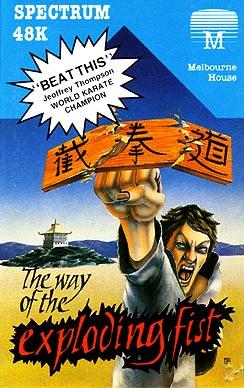The Way of the Exploding Fist
| The Way of the Exploding Fist | |
|---|---|

ZX Spectrum Cover art
|
|
| Developer(s) | Beam Software |
| Publisher(s) | Melbourne House |
| Designer(s) | Gregg Barnett |
| Platform(s) | Acorn Electron, Amstrad CPC, BBC Micro, Commodore 16, Commodore 64, ZX Spectrum |
| Release date(s) | June 1985 |
| Genre(s) | Fighting game |
| Mode(s) | Single player; Two-player |
| Review scores | |
|---|---|
| Publication | Score |
| Crash | 92% |
| Sinclair User | |
| Computer Gamer | 14/20 |
| Awards | |
|---|---|
| Publication | Award |
| Crash | Crash Smash |
| Sinclair User | SU Classic |
| Golden Joystick Awards | Game of the year |
The Way of the Exploding Fist is a 1985 fighting game by Gregg Barnett of Beam Software. Originally developed on the Commodore 64 and published in June 1985 by Melbourne House, ports were made for Amstrad CPC, ZX Spectrum, BBC Micro, Acorn Electron and Commodore 16. It was one of the first games to include realistic graphics and movements and borrows heavily from the Data East arcade game Karate Champ which was released the previous year. An NES version was developed by Beam Software but it was never released.
The name of the game is probably a play on Bruce Lee's fighting system Jeet Kune Do, which can be translated to "Way of the Intercepting Fist".
Karate champion Jeoffrey Thompson was signed to promote the game but was not sufficiently well known to have the game named after him.
The player takes part in a series of one-on-one karate matches, all overseen by a wise old expert who appears somewhere in the background. Once the player defeats an opponent they move up to the next stage and a more difficult adversary. Fights were not won using the energy-bar style found in modern fighting games but instead the player needed to get two complete yin-yangs. Any move that connected with the opponent would end the round; a loosely timed or borderline kick or punch would obtain half a yin-yang icon, while a well-executed move would obtain a full icon. Two complete icons ended the bout and progressed to the next level.
This system of scoring, known as shobu nihon kumite, is used in real life in many traditional styles of karate. A half yin-yang represents a waza-ari (a committed but not decisive technique) and a full yin-yang represents an ippon score (full point, decisive finishing blow).
...
Wikipedia
